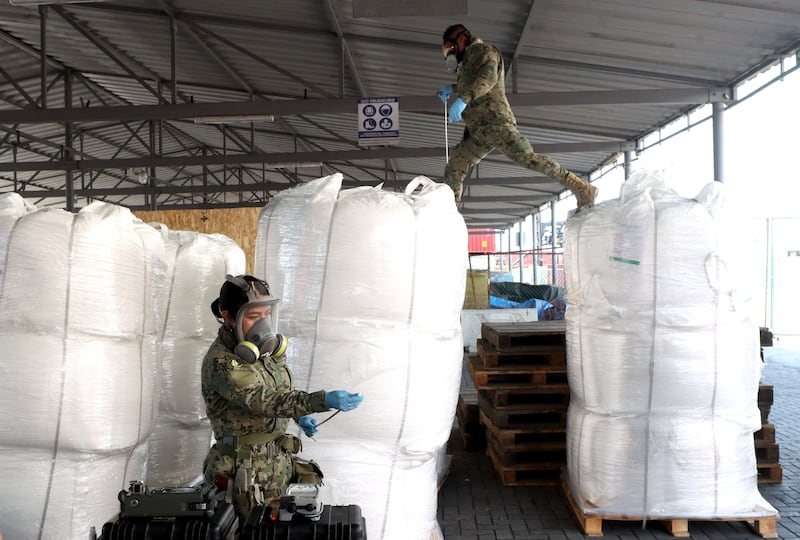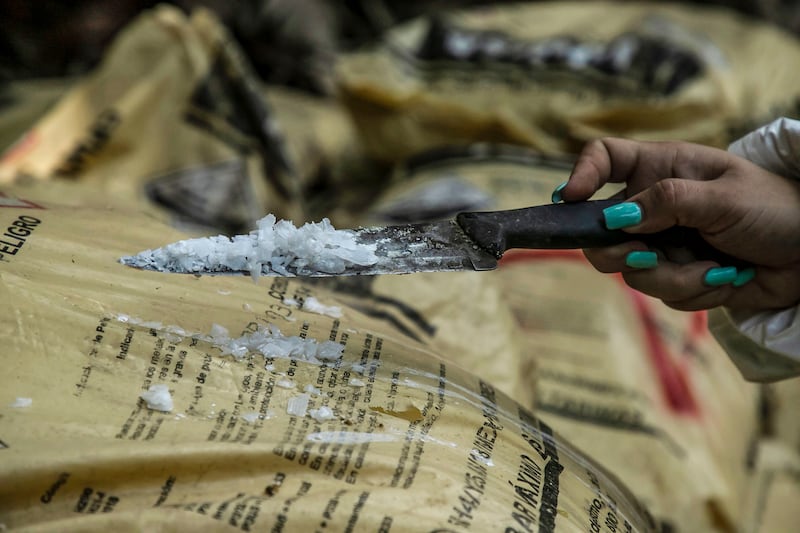One Sunday morning in May, after leaving a restaurant in western Mexico, Sergio Emmanuel Martínez, a new customs director at the country’s largest port, was kidnapped.
The next day, he was found dead beside a motorway, making him the fourth customs official at the port of Manzanillo to be murdered in less than two years.
Manzanillo is a bustling centre of global commerce but it is also an entry point for chemicals from China that are used to make the synthetic opioid fentanyl.
Like other Pacific coast hubs, its importance to the drugs business has risen sharply with the fentanyl boom, triggering a violent battle among cartels for control of the port. President Andrés Manuel López Obrador said Martínez’s death was related to measures taken to stop illegal imports.
“The people that come to work in customs are subject to pressures,” Griselda Martínez, Manzanillo’s mayor, told the Financial Times. “If they accept what one group proposes, they are killed ... and if they don’t accept, they are too.”
In the last decade, fentanyl has become the leading cause of death for young adults in the US. Mexico’s illegal drug trade has also adapted to the shift from plant-based drugs towards synthetics, creating a new, streamlined and highly profitable arm of the illicit business with fewer workers and lower costs – but just as much violence.
The change has caused friction in two of Washington’s most important relationships, with China and Mexico. It is also fast becoming a priority for US Republicans in advance of the country’s 2024 presidential election, with candidates rolling out ever more radical proposals for measures against both nations.

Stopping the supply is not easy.
In Manzanillo, cranes lift newly arrived containers filled with everything from clothes and powdered milk to car parts. On the dusty back roads, trucks carrying rolled steel await deployment and men in high-vis jackets zip around on motorbikes carrying essential paperwork.
The port handles 9,500 six-metre equivalent units a day, including some 30 per cent of the country’s maritime imports. Even without threats and corruption, Mexico’s customs – now under the control of the navy – would struggle to find the tiny amounts of input chemicals needed to make fentanyl among this vast load, experts said. Adding to the complexity, many of the ingredients can also be used for legal purposes, as can the highly potent fentanyl itself.
All the fentanyl needed to supply the US for one year weighs the equivalent of five tonnes and would easily fit into one lorry, according to researchers at Rand Corporation. That compares with about 125 tonnes for heroin and even more for cocaine.
“It’s not a needle in a haystack, it’s the hole in the needle in the haystack,” said Peter Reuter, public policy professor at the University of Maryland.
From the port, the chemicals are taken to Mexico’s northern states and mixed and pressed into pills, experts said. Unlike vast fields for poppies or marijuana, which depend on suitable weather production, synthetic drug “laboratories” can be set up quickly in houses and go undetected even in urban areas.
Instead of employing tens of thousands of agricultural labourers, the entire fentanyl industry in Mexico could function with “cooks” estimated to number in the hundreds, who were mostly not qualified chemists, Reuter said. Fentanyl’s growth appears to have hit heroin production in particular, with poppy growing in Mexico still well below its peaks, according to the UN Office for Drugs and Crime.
At one rudimentary lab in the hills of Sinaloa, two teenage boys in latex gloves sat at a table piled high with fentanyl powder, previously cooked in uncontrolled conditions, according to a TV report for Mexico’s Televisa. They filled 21,000 capsules a week and were paid about $330, they said.
“It’s not a lot of money, but everywhere pays so little. It’s boring too,” said one of the masked men, who were making the drugs for the Sinaloa Cartel.
From there, the drugs are transported across the land border by “mules”, who are often American women, according to a recent US indictment. Some are flown over in private planes. The fentanyl was then distributed using similar US networks as for other drugs, experts said.
Fentanyl now causes most of the more than 85,000 annual opioid overdose deaths in the US and Canada. While the toll from many other drugs affects countries across the world, deaths from overdoses of fentanyl, originally developed in the 1950s as a painkiller, are concentrated in North America.
Though the US epidemic was fuelled by doctors overprescribing opioids, fentanyl is also now mixed into many other illegal drugs. Mexican drug cartels now even cut in other substances, such as the animal tranquilliser xylazine. Europol has raised concerns about its development in Europe, but it has yet to take off there at scale.
US lawmakers from both parties say Mexico needs to do more to stem the supply of fentanyl, with some even suggesting US military intervention against the cartels. In his June meeting with Chinese president Xi Jinping to thaw relations, US secretary of state Antony Blinken stressed the need for co-operation on the issue. Both Mexico and China, which says it has taken “unprecedented measures” to control fentanyl and similar substances, argue that US consumer drug demand is the true source of the problem.

Mexico in particular says it is already paying a high price. The drug cartels’ shift to fentanyl to supply North America, which a recent US indictment alleges started around 2014, has fuelled violence at home, where homicides hit record numbers from 2018 to 2020 and are now only slightly down.
Fentanyl had been a source of conflict between the country’s two pre-eminent groups, the Sinaloa Cartel and Jalisco New Generation Cartel (CJNG), said Falko Ernst, senior Mexico analyst at the International Crisis Group.
“It’s definitely become a big driver of violence in Mexico,” Ernst said. “It’s a huge cash cow for those who have access to it.”
Parts of Mexico’s poor, rural highlands, where poppies were grown to make heroin, have also undergone an economic slump as consumers shifted to fentanyl.
Tens of thousands of farmers in Guerrero, Sinaloa and other states now have incomes just a tenth of those they made at the height of the US heroin boom in 2015-17, according to Romain Le Cour Grandmaison, a senior expert at the non-profit Global Initiative Against Transnational Organized Crime.
[ Fentanyl could be next wave of drugs crisis in Ireland, expert warnsOpens in new window ]
“There is this notion that drugs are the most profitable product in the world, that it is a recessionproof industry, but what [we’ve documented] ... is a quite unprecedented economic crisis surrounding a drug,” Le Cour said.
Despite evidence to the contrary, president López Obrador claims that fentanyl is not produced in Mexico. At the same time his government recently committed to a series of new measures to “dramatically reduce” precursor chemicals coming in, including stepping up vigilance at its ports.
In Manzanillo, Sinaloa and the CJNG are fighting for control of the port city. In 2019, two armed assassins on motorbikes tried to kill mayor Martínez, who is from López Obrador’s Morena party.
Bodyguards saved her, and four years on she lives in a government building away from her family, protected by more than a dozen armed officials.
“Having a security detail takes your life away,” she said, adding that her attackers had still not been caught. “This should never be normalised. It shouldn’t be this way.” – Copyright The Financial Times Limited 2023




















